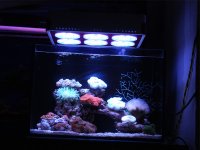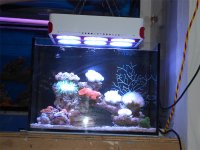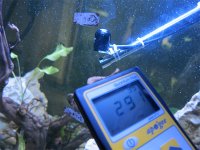- Location
- USA
This is my small saltwater tank size:
25x15x20 in inch.
I got a LED aquarium light last week and it arrived yesterday.
It is built with 72pcs 3W LEDs, input voltage 3.8,input current 700 mA.
The actual power 192W.
Based on White 12000-14000K:460nm=2:1, below is its PAR reading and lumens, covering area:
2 inch:113,300 lux. PAR value:1760 m-2s-1.
12 inch:112,300 lux,1280mmol;coverage:0.8 ?.
20 inch:78,000 lux, 728mmoll;coverage:1.12 ?.
And as my tank is only 20inch deep, we measured the other data in my friends' tank.
30 inch :46,000 lux, 265mmol; coverage:1.28 ?.
40 inch: 18,900 lux,206mmol; coverage: 1.76 ?.
60 inch: 14,400 lux,138mmol; coverage: 2.269 ?.
But now it seems this 192W powerful LED aquarium light is too strong for my little tank, I am going to get another lower power LED, probably 24pcs blue 460nm and 24pcs White 14000K,total power 130W is enough.
Since my tank is only 30gallon, should I based on the 3W/gallon criterion and choose a 90W LED light for it?
Now here is the picture, does anyone can offer some advice, thank you~ :tongue:
25x15x20 in inch.
I got a LED aquarium light last week and it arrived yesterday.
It is built with 72pcs 3W LEDs, input voltage 3.8,input current 700 mA.
The actual power 192W.
Based on White 12000-14000K:460nm=2:1, below is its PAR reading and lumens, covering area:
2 inch:113,300 lux. PAR value:1760 m-2s-1.
12 inch:112,300 lux,1280mmol;coverage:0.8 ?.
20 inch:78,000 lux, 728mmoll;coverage:1.12 ?.
And as my tank is only 20inch deep, we measured the other data in my friends' tank.
30 inch :46,000 lux, 265mmol; coverage:1.28 ?.
40 inch: 18,900 lux,206mmol; coverage: 1.76 ?.
60 inch: 14,400 lux,138mmol; coverage: 2.269 ?.
But now it seems this 192W powerful LED aquarium light is too strong for my little tank, I am going to get another lower power LED, probably 24pcs blue 460nm and 24pcs White 14000K,total power 130W is enough.
Since my tank is only 30gallon, should I based on the 3W/gallon criterion and choose a 90W LED light for it?
Now here is the picture, does anyone can offer some advice, thank you~ :tongue:








